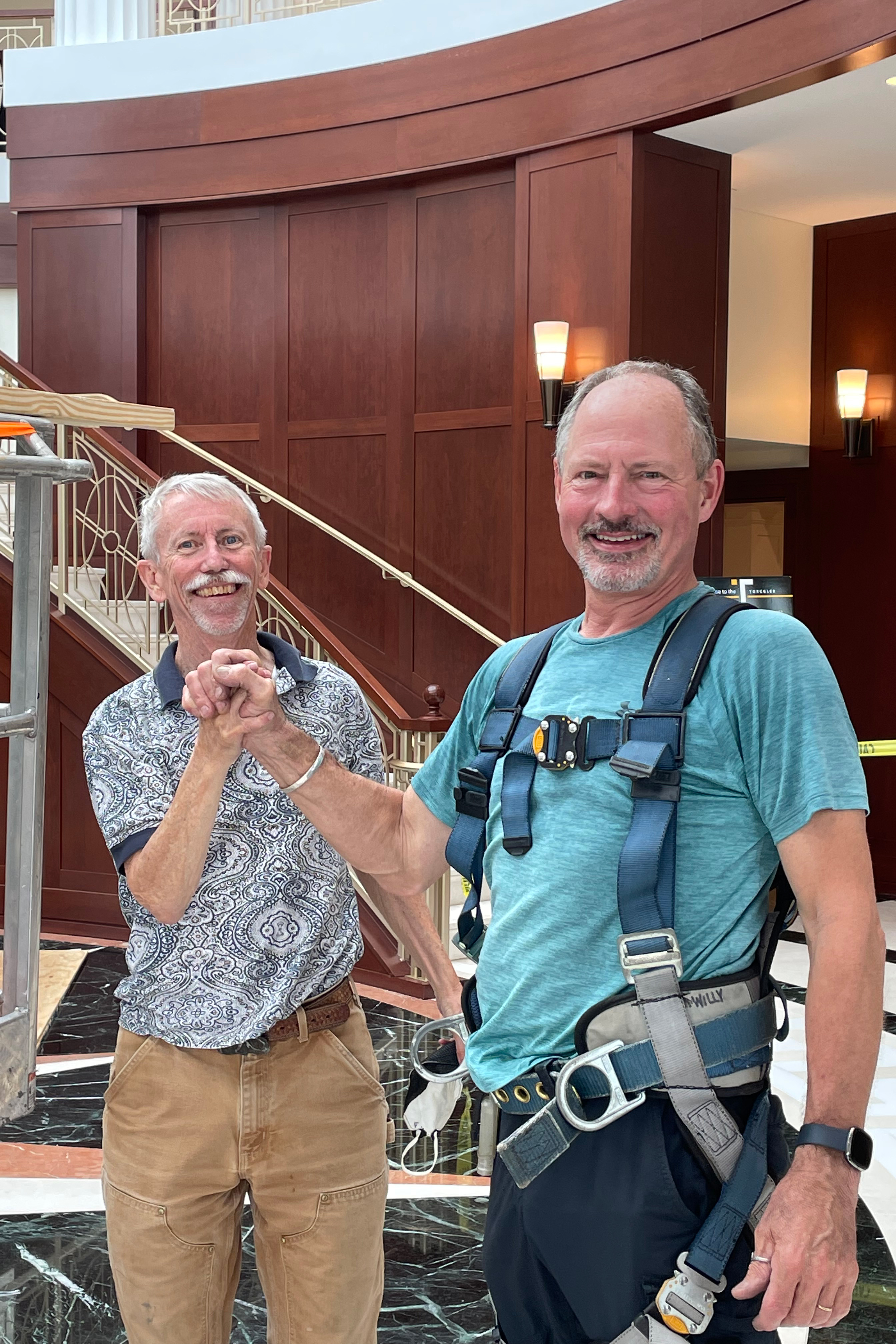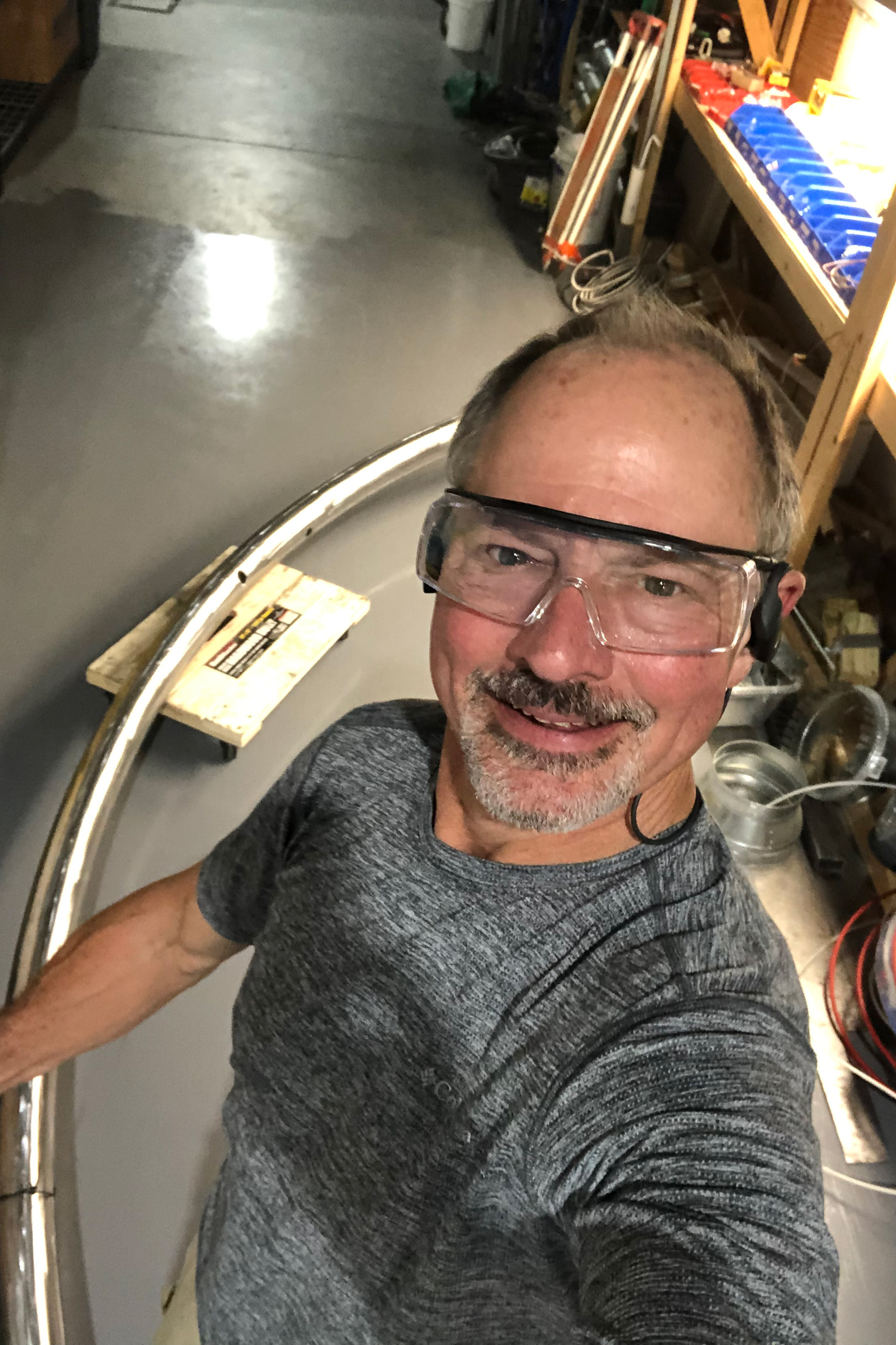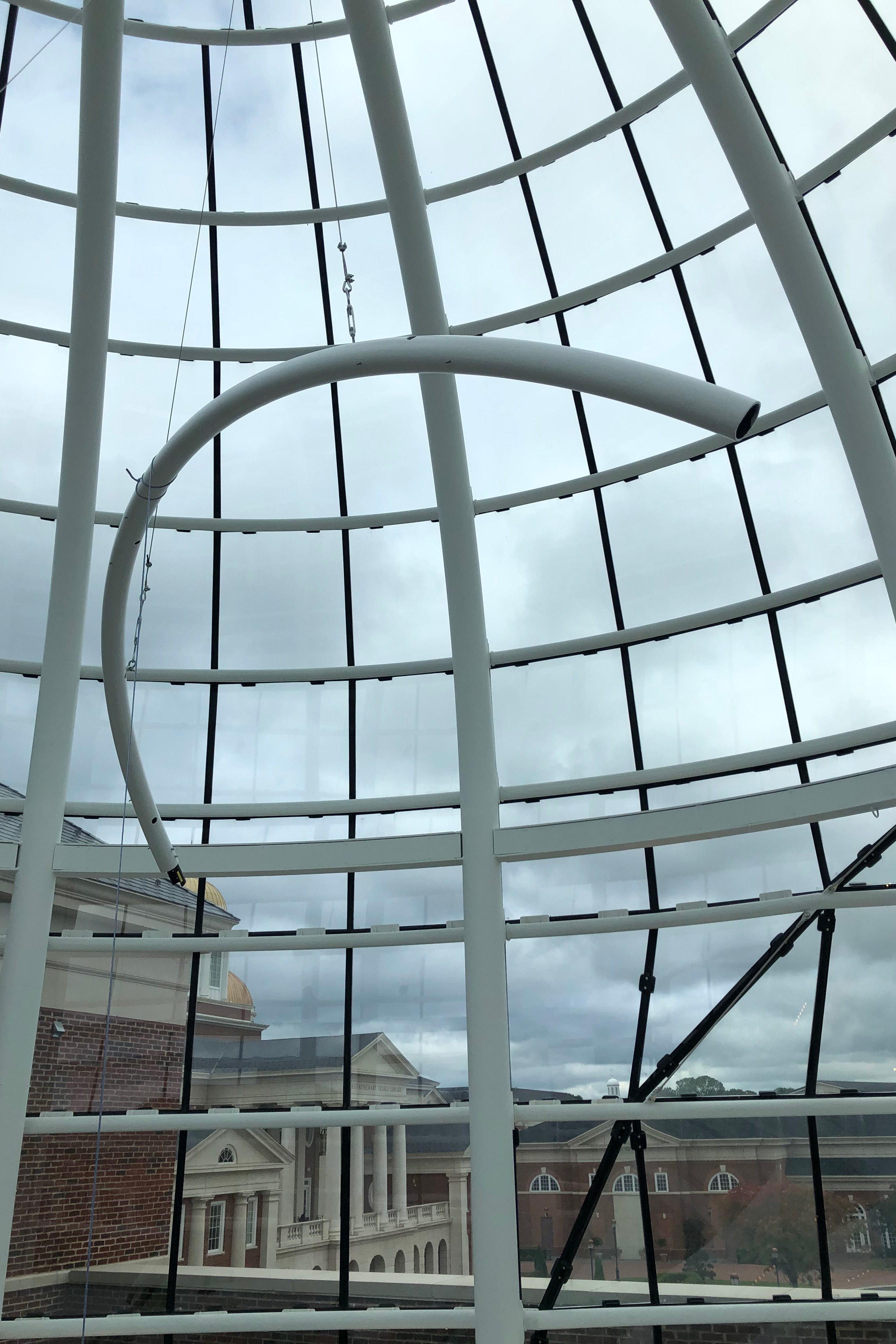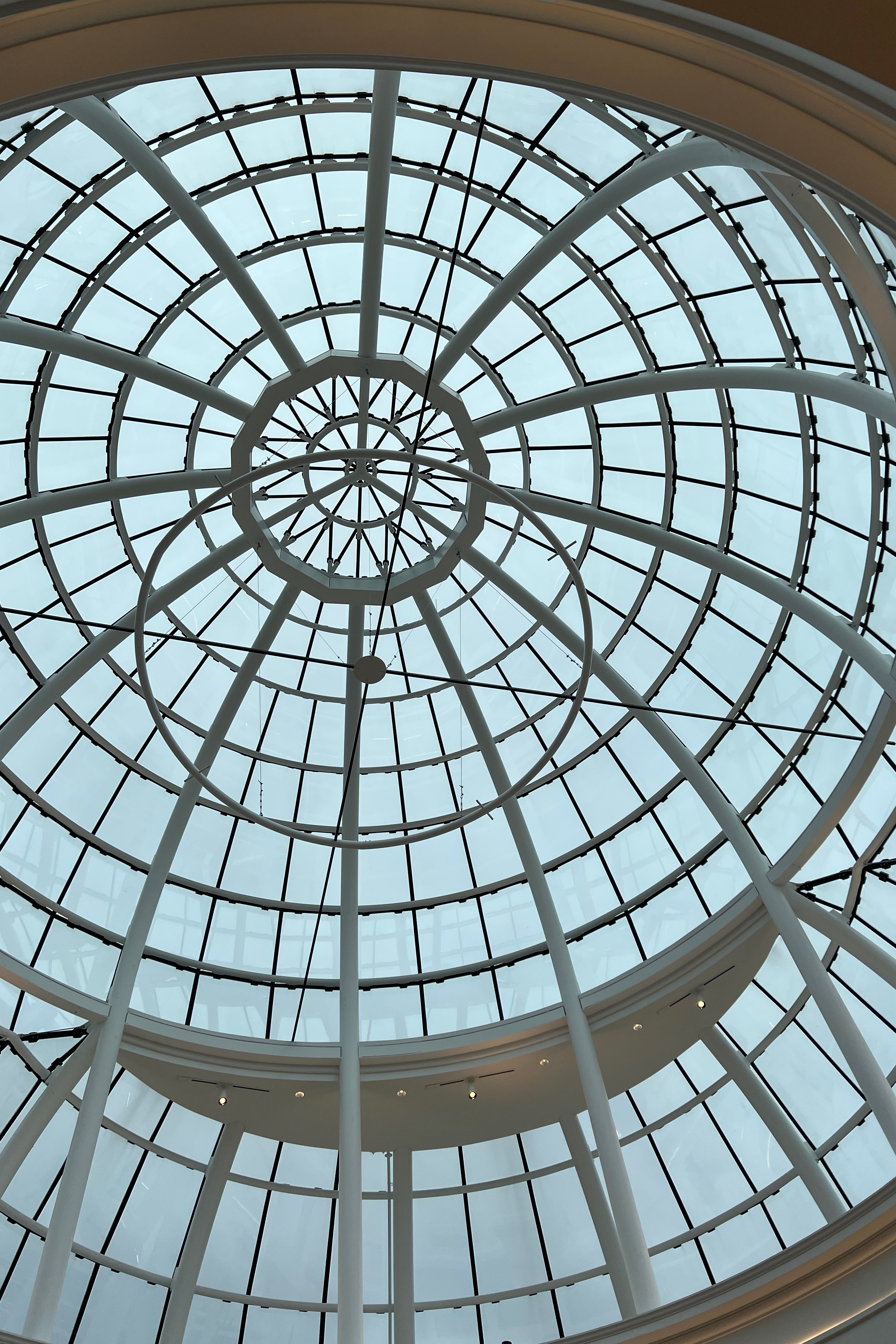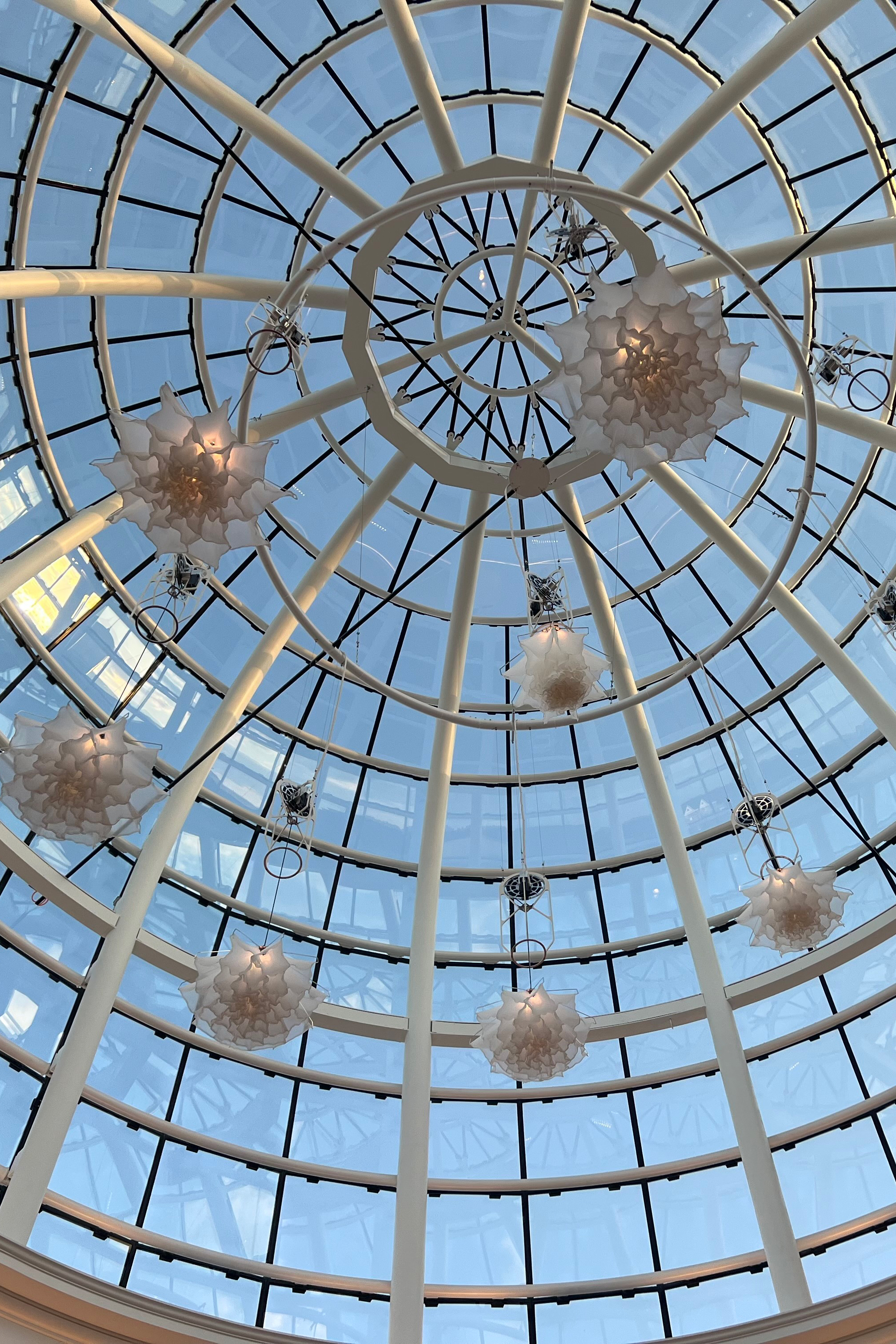Art installation opens to the public as part of the grand opening of the Mary M. Torggler Fine Arts Center
NEWPORT NEWS, VA – On Halloween weekend, the glass rotunda of Christopher Newport University’s Mary M. Torggler Fine Arts Center came alive with the nearly silent swish and glow of beautiful white apparitions. But these were no ghosts: The white and billowy, flower-shaped lights that daintily rise and fall are part of a kinetic art installation called Shylight.
The Shylight installation at CNU is a collaboration between a team of Dutch artists called DRIFT, who designed the piece, and Kevin Jordan, an engineer at DOE’s Thomas Jefferson National Accelerator Facility. Joined by creative partner and retired Jefferson Lab scientist, George Neil, Jordan engineered the permanent steel structure that holds the Shylight exhibit within the rotunda.
“Shylight is inspired by the process of nyctinasty, in which certain flowers will rhythmically close at night,” explains Holly Koons, Executive Director of the Torggler Center. “Shylight consists of nine suspended silk ‘buds’ that are set into choreographed rising and falling motion by motors that are regulated by a computer program. As the buds drop from the top of the rotunda, they swell into a marvelous bloom, lit from within by warm LED lights. Then they rise, shyly curling back into a bud form before descending again.”
The “bloom” that happens to each flower bud as it drops is made possible by the mechanical spreading of a scaffolding-like structure that supports the silk petals. Simple wind resistance causes the silk petals to balloon outward like a parachute as they descend. According to Jordan, this motion can be played in sync with music or in any desired pattern.
When art and engineering combine
According to DRIFT, “the relationship between nature, humans and technology is key” to their creations. For their kinetic art installations to work, technology must be incorporated into the art itself.
To bring Shylight to life, it not only needed a structure upon which it could be mounted, but that structure also needed to enable the technology to function. That structure also needed to hide the cables and cords that power each individual bud.
“DRIFT initially imagined the nine buds mounted to a ring that was ten feet across,” describes Jordan. “Once we got into the rotunda, we realized ten feet was too small, so we designed a 17-foot ring to be mounted 42 feet above the ground.”
Jordan and Neil designed a steel ring that they then permanently installed in the rotunda. Each light, along with its computers and cables, attaches to the steel ring in a way that blends into the dome structure.
“There are nine lights and a little computer for each of the nine lights,” explains Jordan. Each light also has a motor and electronics. The computers are hidden in the box ducts, and cables run along the steel tubes and aluminum channels of the hanging ring. The structure weighs 1,000 pounds and has a safety factor of >5.
“While there are other site-specific installations of Shylight around the world, the Torggler’s installation is the first to be suspended in a transparent glass dome,” says Koons.
For most Shylight installations, the necessary wiring and computer controllers are hidden behind a ceiling. Suspending the work in a transparent space posed a unique challenge. Jordan and Neil met this challenge by creating a ‘loop’ structure with aluminum “C” channels that accommodates the necessary wiring. They also identified other areas in the dome to discreetly house equipment.
Jordan, who considers himself a perfectionist, wanted the ring to blend into the rotunda as much as possible. After having the steel tubes fabricated, he painted them with five coats of paint to match the color of the existing rotunda frame. Once the structure was in place, he then caulked all of the seams to eliminate even a hint of a joint that would detract from the art itself.
“We want our structure to be transparent and to not take anything away from the art,” he says.
All told, Jordan estimates that he and Neil spent approximately 200 hours over three months creating and installing the ring.
Engineering art
For many artists, the structure upon which a piece of art is mounted is considered to be part of the art. Jordan agrees with this view.
“At some level, am I creating art or am I just supplying a piece of pipe?” he asks. “I consider myself an artist, and I consider the mounting ring we made to be part of Shylight. All my life, I’ve built things and I’m careful about the design of them. Where do you step over that threshold to where you’re an ‘artist’ and you step outside of the box to be more creative? I think we do that.”
In addition to his work at the lab, Jordan, along with Neil, runs an art design and installation company called Double Helix Art. One of their public art installations got the attention of Newport News City Manager Cindy Rohlf. It was Rohlf who recommended the pair to Koons when she was having a tough time finding a company that would create a suitable hanging system for Shylight.
“I’d been trying for over a month to identify a company that could produce a hanging system for DRIFT, and no one would agree to it,” explains Koons. “And then one day I was at a meeting with Rohlf. I was sharing my excitement about Shylight and mentioned that I had not yet identified anyone to produce a hanging system. She told me about a kinetic art installation the city had recently sponsored by Double Helix Art and suggested that the two men behind it could be helpful.
“Kevin is extremely high-energy and his own creative impulses are manifested with his work with Double Helix Art,” Koons says.
Neil agrees.
“Kevin is a Jack-of-all-trades with great ideas and many technical skills, so it complements and greatly expands the range of the things I could do by myself,” says Neil. “He brings a terrific enthusiasm and contagious level of energy to everything he works on. He also really loves the social aspect of our work in bringing pleasure to other people and establishing new friends.”
Resources
View the Double Helix public art installation at Brooks Crossing in Newport News.
View a behind-the-scenes demonstration of Shylight, including a view of the mechanical systems.
View Shylight in person at Christopher Newport University
The Mary M. Torggler Center at Christopher Newport is now open to the public. Admission to all exhibitions at the Torggler is free. Shylight, Night Light and other exhibitions are available for viewing by the public. In addition to exhibitions, the Torggler offers year-round art classes and workshops for children and adults. More information can be found at thetorggler.org.
By Carrie Rogers
Contact: Kandice Carter, Jefferson Lab Communications Office, kcarter@jlab.org


